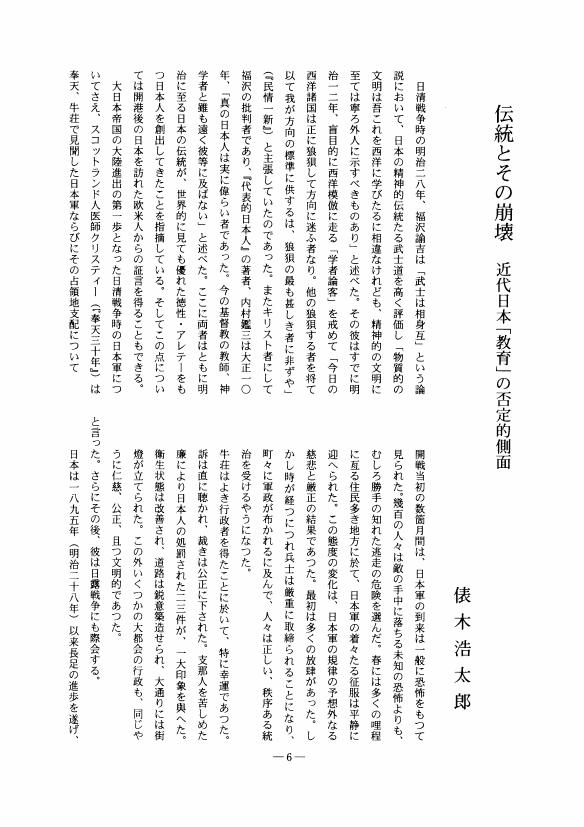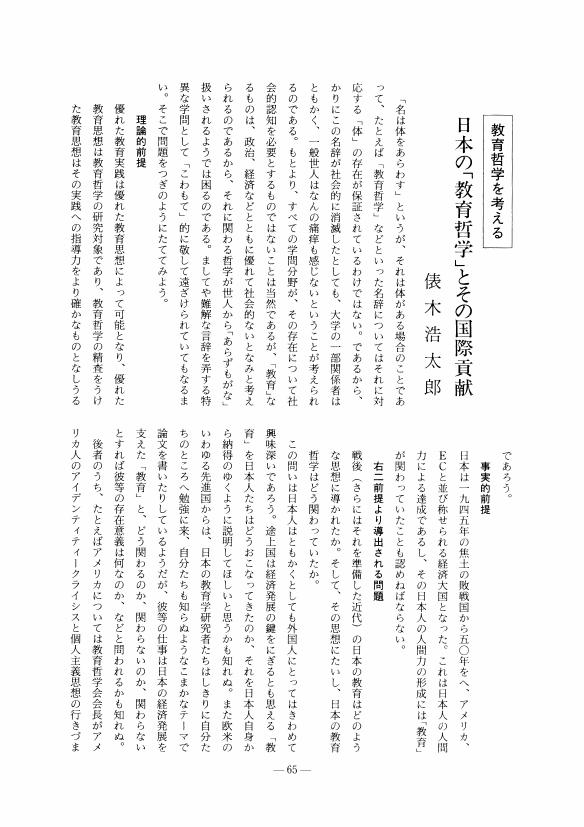2 0 0 0 OA 戦前・戦後の「教育」概念への問い
- 著者
- 俵木 浩太郎
- 出版者
- 教育哲学会
- 雑誌
- 教育哲学研究 (ISSN:03873153)
- 巻号頁・発行日
- vol.1997, no.75, pp.23-27, 1997-05-10 (Released:2009-09-04)
1 0 0 0 OA アフター・ヴァーチュー?イエット・ヴァーチュー! 日本的啓蒙の確認の試み
- 著者
- 俵木 浩太郎
- 出版者
- 教育哲学会
- 雑誌
- 教育哲学研究 (ISSN:03873153)
- 巻号頁・発行日
- vol.2000, no.82, pp.81-93, 2000-11-10 (Released:2009-09-04)
- 参考文献数
- 24
1 0 0 0 OA 伝統とその崩壊 近代日本「教育」の否定的側面
- 著者
- 俵木 浩太郎
- 出版者
- 教育哲学会
- 雑誌
- 教育哲学研究 (ISSN:03873153)
- 巻号頁・発行日
- vol.1998, no.77, pp.6-13, 1998-05-10 (Released:2009-09-04)
1 0 0 0 OA 教育哲学を考える 日本の「教育哲学」とその国際貢献
- 著者
- 俵木 浩太郎
- 出版者
- 教育哲学会
- 雑誌
- 教育哲学研究 (ISSN:03873153)
- 巻号頁・発行日
- vol.1993, no.68, pp.65-66, 1993-11-10 (Released:2009-09-04)
1 0 0 0 OA 教育における合理主義と非合理主義 「近代学校」と合理主義
- 著者
- 俵木 浩太郎
- 出版者
- 教育哲学会
- 雑誌
- 教育哲学研究 (ISSN:03873153)
- 巻号頁・発行日
- vol.1991, no.63, pp.1-4, 1991-05-10 (Released:2009-09-04)
1 0 0 0 OA 幼な子の怒り
- 著者
- 俵木 浩太郎
- 出版者
- 教育哲学会
- 雑誌
- 教育哲学研究 (ISSN:03873153)
- 巻号頁・発行日
- vol.1985, no.52, pp.30-42, 1985-11-10 (Released:2009-09-04)
The author tries to elucidate the meaning of Jesus' paradoxical teaching 'unless you turn and become like children, you will never enter the kingdom of heaven.Though an analogy like 'child' can have various connotations, the author singles out an aspect that children are pure and sincere in their wrath. However, the treatment of wrath as a psychological fact can differ from one culture to another. In Japan where paternalistic ideology has been dominant historically, patience and obedience are highly valued and wrath tends to be regarded as a vice per se, partly similar to old Jewish society. In classical Greece, on the other hand, wrath seems to have been recognised as something natural for human beings. In order to support this view the author refers to the wrath of Achilles and to the Aristotelian explana-tion of anger. (Nic.Eth. IV, v).Taking this difference into consideration, one can interpret Jesus' indignation in the temple of Jerusalem as a paradigmatic case of being like a child in the teaching of Jesus. This interpretation reminds one of Dostoevsky's novels The Brothers Karamazov in which a pure and tense wrath of a child and his death play an important role. There wrath is sympathetically understood by Alyosha, the youngest of the brothers who seems to be a personification of an ideal educator and friend of the young invented by the novelist. The author suggests that this novel can be interpreted as Dostoevsky's attempt to explain the teaching of Jesus.By way of conclusion the author proposes to interpret wrath of children as a symptom of their drive to grow. Thus, adults can arrive at a better understanding of what children are like and support children' vigorous growth.
1 0 0 0 OA 教育関連概念の史的形成過程の解明 接点探究の一つの試み
- 著者
- 俵木 浩太郎
- 出版者
- 教育哲学会
- 雑誌
- 教育哲学研究 (ISSN:03873153)
- 巻号頁・発行日
- vol.1985, no.51, pp.25-28, 1985-05-10 (Released:2009-09-04)
およそ哲学は概念そのものを問うという知的作業を欠くことができない。と同時にいかなる概念も歴史の所産という面をもつことを免れがたい、とすれば、教育にかかわる諸概念の解明に努めんとするかぎりでの教育哲学も、歴史への配慮を欠きえないことになる。かくして「教育研究における哲学的アプローチと歴史的アプローチの接点」は求められて然るべきものとなる。にもかかわらず、とくに教育研究においてはその接点を求める上でつぎの難点が存在する。第一は教育が人を変化・成長する過程における存在として把握することを求めるものであるのにたいし、哲学が伝統的に取扱いなれているのは名詞、形容詞で示されるような固定的、静的概念である、という点である。第二は人間形成を歴史の流れのうちでとらえようとするとき、経済史における貨幣、法制史における実定法といった鍵概念の具体性に匹敵する具体的鍵概念を見出しにくい、という点である。こうした難点をともかくも意識しつつ以下に接点探究の一つの試みを示す。
1 0 0 0 OA 杉浦 宏編『アメリカ教育哲学の展望』
- 著者
- 俵木 浩太郎
- 出版者
- 教育哲学会
- 雑誌
- 教育哲学研究 (ISSN:03873153)
- 巻号頁・発行日
- vol.1982, no.46, pp.80-85, 1982-11-15 (Released:2009-09-04)
1 0 0 0 OA 「育」意考
- 著者
- 俵木 浩太郎
- 出版者
- 教育哲学会
- 雑誌
- 教育哲学研究 (ISSN:03873153)
- 巻号頁・発行日
- vol.1979, no.39, pp.17-30, 1979 (Released:2009-09-04)
This paper follows after The Meaning of “kyo”, (Studies in the Philosophy of Education No. 38, 1978), intending to clarify the meaning of kyo-iku, a lexical equivalent word to education.Through examining all 24 cases of iku in the Four Classical Chinese Books and the Five Chinese Classics, the author finds that only one case means “bringing up” a child by parents. Majority of the cases doesn't give rise to the meaning, around which present usages are centering. Later, Xu Shen (58 A. D.-147 A.D.), a compiler of a dictionary for Chinese characters, explained iku as “bringing children up to make them do good”.The author concludes that since then iku in this sense has become influencial, and that in the present usage of kyo-iku this sense still exists. Furthermore, it is pointed out that Xu combined the iku with kyo holding an intention to mean bringing up children good by teaching. Thus, one can find that an embryonic form of the concept of kyo-iku in its modern usage had been born. On the contrary, the author is dubious about a widely held opinion that the usage of kyo-iku in the sense of “education” was originated by Mencius some four centuries before Xu.
1 0 0 0 OA 「教」意考
- 著者
- 俵木 浩太郎
- 出版者
- 教育哲学会
- 雑誌
- 教育哲学研究 (ISSN:03873153)
- 巻号頁・発行日
- vol.1978, no.38, pp.1-14, 1978-01-31 (Released:2009-09-04)
As is well known, interest in words used in daily conversation is increasing in the world of Anglo-saxon philosophy (including philosophy of education). This intellectual interest may very much look like a troublesome discussion; but in so far as the interest in words is an essential condition for philosophizing, there is no fundamental difference between the trends observed in contemporary Anglo-saxon philosophy and when one calls philosophy the effort to clarify concepts concerning Japanese language.In this paper, by clarifying the concept of kyô (教), the attempt is made to discover a meaning which may be hidden in the Japanese concept of kyôiku (education).In the Japanese language meaning is expressed by a parallel use of ideogramms and phonetic symbols; the corresponding relation between meaning and sound is not always accurately determined. The Japanese reading of oshie (教) of the ideogramm kyô is merely based on present common usage. On the other hand, the ideogramm oshie has a history of about 3,000 years behind it and during this long period must have had some meaning.The auther believes that the ideogramm kyô first was used in a context as an ideogramm and subsequently received social recognition during the process of being applied repeatedly; starting from this presupposition, an analysis of paradigmata is conducted within the frame of the Four Classical Chinese Books and the Five Chinese Classics (shisho-gokyô).It turns out that the term kyô carried the meaning of one way of transmitting word-meaning from a person superior in power to a person in a lower position. Power here first of all means the State orthe King. It is noteworthy that Confucius in the Rongo (Analects) when he refers to his activity of teaching his disciples does not use the ideogramm kyô (教) but the ideogramm kai (誨).Also later, in the Kan-Period, in the Raiki (Book of Etiquette) the concepts of kyô (教), gaku (学) and shi (師), were apparently systematically determined in close connection with state government. Refering to Eifu Motoda's Kyôgaku Taishi, it may be pointed out that this conceptual frame continued into the (Japanese) Meiji Period. Furthermore, Motoda was unable to distinguish between kyôiku and kyôgaku, and it is assumed that his influence was at work when the meaning of kyôiku in Japan was finally fixed at the time when the Kyôiku Chokugo (Imperial Rescript on Education) was issued.Between this traditional use of the term kyoiku in Japanese and the term “edcation” in European languages with its long history dating back as far as to the paideia, a certain lack ofconformity arises. This may be proved by the way in which the developmental concept of education has been treated. The author believes that the latter was foremost in the mind of Yukichi Fukuzawa when he stated, “The term kyôiku is not appropriate. It would better be changed to hatsuiku.” When one keeps in mind what was said here, one may ask the question whenever the term kyôiku is used whether this means what Motoda refers to as kyôgaku or whether it is used in the developmental meaning of Fukuzawa. The author hopes that along these lines the concept of kyôiku will be further clarified may be made better to correspond to the term “education.”
1 0 0 0 OA カント『教育学』における「批判」的方法
- 著者
- 俵木 浩太郎
- 出版者
- 教育哲学会
- 雑誌
- 教育哲学研究 (ISSN:03873153)
- 巻号頁・発行日
- vol.1974, no.30, pp.16-29, 1974 (Released:2009-09-04)
- 参考文献数
- 33
There are theories attempting to interpret Kant's “Pedagogy” as a product of his enlightenment philosophy trying to separate it from his critical philosophy (e. g. Sukeichi Shinohara, “Oshu Kyoiku Tetsugakushi” (History of Western Educational Thought)). The contention of this paper sustained by an examination of the principle of the twofold division which Kant adopted in his “Pedagogy” is that this is not different from the 'critical' method. In this process of examination the author considers as the methodological principles of 'criticism' the following three points : 1. The articulation structure of the dialectic pure reason- “Pure Reason” 2. The analysis and synthesis in the judgment- “Pure Reason” 3. The method of an analytical twofold division and the method of a threefold synthetic division- “Critique of Judgment” In addition, as a prerequistite condition for the possibility of such an examination, we shall refer to the maxims of Kant's use of words and to his circumspection in the application of educational terminology.The method of a twofold partition of the positive and the negative, the condition of a twofold analytical division into the natural and the practical and the method of the threefold division in moral education are discussed and we finally arrive at what may be called a fourfold division. When it comes to this point, no formal possibility can brought out, no matter how well Kant's morality is explained and an educational principle in the world of experience cannot be deduced thence, rather the foundation must be sought in common sense, -that is what we maintain. The main theme of this paper is an attempt to discover a 'critical' aspect in “Pedagogy” through a negative approach to this morality.





